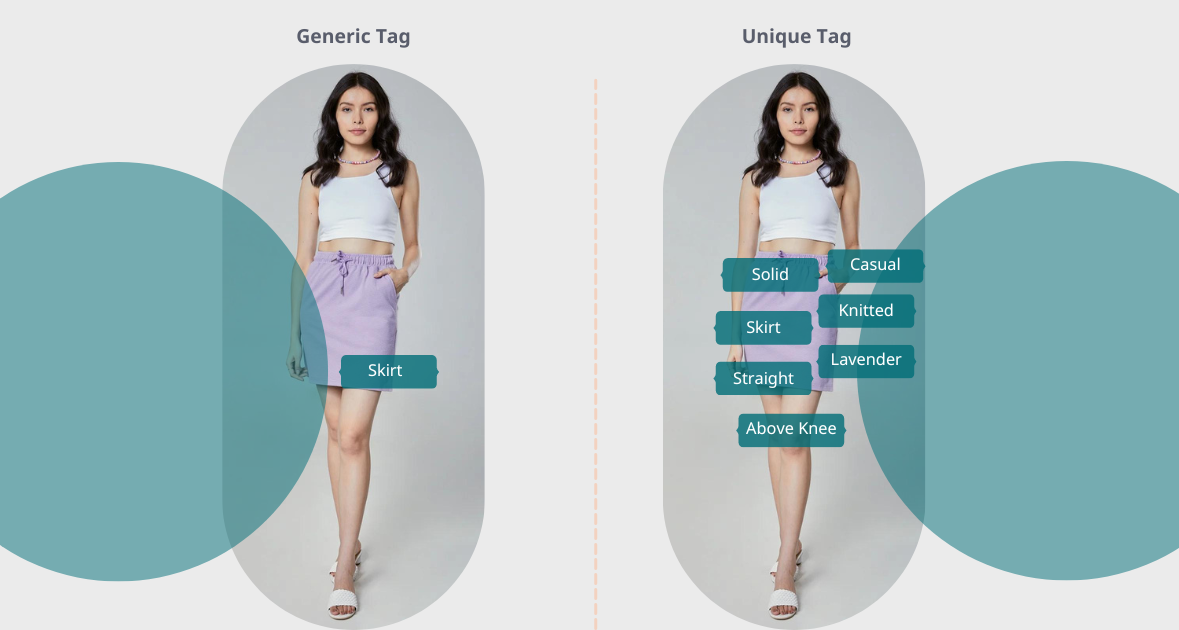Product tagging – what is it? Why is product tagging important? The process of assigning keywords to products is known as product tagging. All graphics should have product tags assigned to enhance product discovery, catalog efficiency, and the overall retail experience. However, the majority of retailers and brands currently manually update tags and product details. Deploying AI-driven next-generation product tagging systems like ClasifAI's automated product tagging technology can automate this tedious task.
What is Automated Product Tagging?
Every product in an online store is labeled with a variety of tags that identify its features, qualities, and category. Each item has a unique tag, indicating that each product is unique.
These tags include information about the product that a consumer should be aware of, such as color, size, brand, measurement, usage, sale, and more. A dress, for example, may contain tags like black, midi silk, summer and sleeveless, and so on.
What is the Process of Product Tagging?
Tags that make it easier to organize and search through inventory are usually used by retailers to label their catalogs. Manually. Manual labeling is labor-intensive, time-consuming, and superficial. Human bias is another factor that can affect it. In order to change the product tagging game, technology and AI are introduced here. Each item in your catalog is automatically tagged with a variety of attribute labels using AI image tagging.
To achieve this, we employ a number of neural networks that have been trained on regularly updated private datasets. We employ networks for category and subcategory prediction. Given the provided raw image and text metadata, these compute a single high-level category, such as tops, shoes, or outerwear, and a single more detailed category, respectively, for each outfit. The relevant object in the image is located using a different neural network.
Additionally, this enables us to work with images that can have multiple potential items. The properties that are applicable to the specific item are predicted by a final neural network. If it thinks it necessary, this attribute model may predict as many or as few attributes from our taxonomy.
Types of Product Tagging
Manual Product Tagging:
The traditional method of product tagging is manual product tagging.
This implies that the e-commerce store manager or an employee physically applies product tags to product catalog photos. Manual tagging products, like all manual tasks, is prone to human error. Manual tagging can result in mixed supply chains, a lengthy digitization process for new products, and irrelevant search results, resulting in a poor customer experience. To avoid these issues, the catalog information must be clean and well-organized, with precise product information. This will be nearly impossible to achieve if you conduct the retail tagging process manually.
Automatic Product Tagging:
Automatic product tagging, as the name implies, is an automated alternative to manual product tagging. Automatic product tagging is a technique that uses AI algorithms to organize and tag product photos based on their specifics. The advanced image recognition algorithms that leverage deep learning automate and efficiently perform the tagging process without the need for human intervention.
The automatic product tagging process generates metadata for catalog assets automatically. It scans the image for patterns that are associated with specific keywords. Tags created in this manner can collect not only catalog data but also how and where they're being used, who is searching for them, and how they correlate to other tags as their use grows.
Benefits of Automated Product Tagging
Businesses that want to keep up with a rising number of items but lack the time or resources to identify them all manually should use our automated product tagging solution. Your products will be automatically tagged by a system from ClasifAI. It saves your time and money and assists you in maintaining organization and a professional appearance.
Reduce Costs and Time: You don't have to spend hours tagging each product individually when you use an automated tagging system; instead, you can set up a single rule that applies to all products in your inventory.
Product Catalog Management:
Optimized and very well product feeds from the backend are made possible by accurate product tagging to the catalog images. To track offerings, keep track of bestsellers and underperformers, and keep an eye on stock levels, add the appropriate tags to the product catalog image. It is possible to tag products automatically based on styles, sleeve lengths, hemlines, colors, patterns, necklines, and occasions. To stay current with the newest trends, you can occasionally add extra tags. To comprehend sales information at the attribute level, using these tags is a wonderful method to impact upcoming purchases.
Inventory Management:
Utilizing geographically and customer-segment-specific product tags, you can organize and manage your whole inventory for various customer groups, customer tiers, and geographic areas. These tags are versatile, flexible, and quick to respond to changes in your consumer base in the present.
Sort your catalog based on micro and macro trends. By addressing the seasonal changes that have an impact on your customers' top search terms, you can always stay relevant.
Conclusion
Automated tagging has the potential to revolutionize the way retailers, brands, and consumers interact with fashion products and content. Automated tagging can help retailers and brands identify trends and popular items faster, allowing them to make more informed decisions about their product lines, marketing, and inventory management.
Additionally, automated tagging can help consumers find products they are interested in more quickly, allowing them to make better purchasing decisions. Despite the potential benefits of automated tagging, there are still challenges that need to be addressed in order for automated tagging to reach its full potential. These challenges include accuracy, scalability, and cost.

